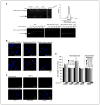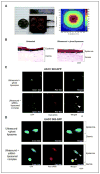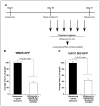Targeting V600EB-Raf and Akt3 using nanoliposomal-small interfering RNA inhibits cutaneous melanocytic lesion development
- PMID: 18794153
- PMCID: PMC3628540
- DOI: 10.1158/0008-5472.CAN-07-6614
Targeting V600EB-Raf and Akt3 using nanoliposomal-small interfering RNA inhibits cutaneous melanocytic lesion development
Abstract
Most events promoting early melanoma development are yet to be identified, but deregulation of the B-Raf and Akt3 signaling cascades is an important regulator of this process. Approximately 90% of normal moles and approximately 60% of early invasive cutaneous melanomas contain a T1799A B-Raf mutation ((V600E)B-Raf), leading to 10 times higher enzyme activity and constitutive activation of the mitogen-activated protein kinase pathway. Furthermore, approximately 70% of melanomas have elevated Akt3 signaling due to increased gene copy number and PTEN loss. Therefore, targeting (V600E)B-Raf and Akt3 signaling is necessary to prevent or treat cutaneous melanocytic lesions. Agents specifically targeting these proteins are needed, having fewer side effects than those inhibiting both normal and mutant B-Raf protein or targeting all three Akt isoforms. In this study, a unique nanoliposomal-ultrasound-mediated approach has been developed for delivering small interfering RNA (siRNA) specifically targeting (V600E)B-Raf and Akt3 into melanocytic tumors present in skin to retard melanoma development. Novel cationic nanoliposomes stably encapsulate siRNA targeting (V600E)B-Raf or Akt3, providing protection from degradation and facilitating entry into melanoma cells to decrease expression of these proteins. Low-frequency ultrasound using a lightweight four-cymbal transducer array enables penetration of nanoliposomal-siRNA complex throughout the epidermal and dermal layers of laboratory-generated or animal skin. Nanoliposomal-mediated siRNA targeting of (V600E)B-Raf and Akt3 led to a cooperatively acting approximately 65% decrease in early or invasive cutaneous melanoma compared with inhibition of each singly with negligible associated systemic toxicity. Thus, cationic nanoliposomes loaded with siRNA targeting (V600E)B-Raf and Akt3 provide an effective approach for targeted inhibition of early or invasive cutaneous melanomas.
Figures






Similar articles
-
Akt3 and mutant V600E B-Raf cooperate to promote early melanoma development.Cancer Res. 2008 May 1;68(9):3429-39. doi: 10.1158/0008-5472.CAN-07-5867. Cancer Res. 2008. PMID: 18451171 Free PMC article.
-
Targeting mitogen-activated protein kinase/extracellular signal-regulated kinase kinase in the mutant (V600E) B-Raf signaling cascade effectively inhibits melanoma lung metastases.Cancer Res. 2006 Aug 15;66(16):8200-9. doi: 10.1158/0008-5472.CAN-06-0809. Cancer Res. 2006. PMID: 16912199 Free PMC article.
-
Melanoma prevention using topical PBISe.Cancer Prev Res (Phila). 2011 Jun;4(6):935-48. doi: 10.1158/1940-6207.CAPR-10-0202. Epub 2011 Mar 2. Cancer Prev Res (Phila). 2011. PMID: 21367959 Free PMC article.
-
Targeting NRAS in melanoma.Cancer J. 2012 Mar-Apr;18(2):132-6. doi: 10.1097/PPO.0b013e31824ba4df. Cancer J. 2012. PMID: 22453013 Review.
-
Functional and therapeutic significance of Akt deregulation in malignant melanoma.Cancer Metastasis Rev. 2005 Jun;24(2):273-85. doi: 10.1007/s10555-005-1577-9. Cancer Metastasis Rev. 2005. PMID: 15986137 Review.
Cited by
-
PTEN gene: a model for genetic diseases in dermatology.ScientificWorldJournal. 2012;2012:252457. doi: 10.1100/2012/252457. Epub 2012 Apr 30. ScientificWorldJournal. 2012. PMID: 22623890 Free PMC article.
-
The T-box transcription factor, TBX3, is a key substrate of AKT3 in melanomagenesis.Oncotarget. 2015 Jan 30;6(3):1821-33. doi: 10.18632/oncotarget.2782. Oncotarget. 2015. PMID: 25595898 Free PMC article.
-
Genetics of melanoma.Front Genet. 2013 Jan 25;3:330. doi: 10.3389/fgene.2012.00330. eCollection 2012. Front Genet. 2013. PMID: 23372575 Free PMC article.
-
Selenium-containing histone deacetylase inhibitors for melanoma management.Cancer Biol Ther. 2012 Jul;13(9):756-65. doi: 10.4161/cbt.20558. Epub 2012 Jun 6. Cancer Biol Ther. 2012. PMID: 22669577 Free PMC article.
-
Applications of nanotechnology for melanoma treatment, diagnosis, and theranostics.Int J Nanomedicine. 2013;8:2677-88. doi: 10.2147/IJN.S45429. Epub 2013 Jul 24. Int J Nanomedicine. 2013. PMID: 23926430 Free PMC article. Review.
References
-
- Satyamoorthy K, Herlyn M. Cellular and molecular biology of human melanoma. Cancer Biol Ther. 2002;1:14–7. - PubMed
-
- Brose MS, Volpe P, Feldman M, et al. BRAF and RAS mutations in human lung cancer and melanoma. Cancer Res. 2002;62:6997–7000. - PubMed
-
- Davies H, Bignell GR, Cox C, et al. Mutations of the BRAF gene in human cancer. Nature. 2002;417:949–54. - PubMed
-
- Yazdi AS, Palmedo G, Flaig MJ, et al. Mutations of the BRAF gene in benign and malignant melanocytic lesions. J Invest Dermatol. 2003;121:1160–2. - PubMed
-
- Miller CJ, Cheung M, Sharma A, et al. Method of mutation analysis may contribute to discrepancies in reports of (V599E)BRAF mutation frequencies in melanocytic neoplasms. J Invest Dermatol. 2004;123:990–2. - PubMed
Publication types
MeSH terms
Substances
Grants and funding
LinkOut - more resources
Full Text Sources
Other Literature Sources
Medical
Research Materials
Miscellaneous

